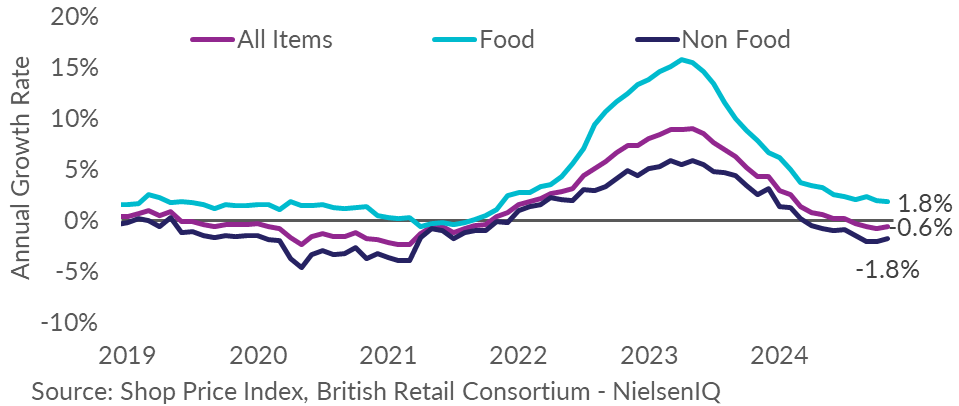Period Covered: 01 – 07
November 2024
- Shop Price deflation was at 0.6% in November, up from
deflation of 0.8% in the previous month. This is slightly above
the 3-month average rate of -0.7%. Shop price annual growth
remained its lowest rate since September 2021.
- Non-Food remained in deflation at -1.8% in November, up from
-2.1% in the preceding month. This is above the 3-month average
rate of -2.0%. Inflation is in-line with levels last seen in
mid-2021.
- Food inflation slowed to 1.8% in November, down from 1.9% in
October. This is below the 3-month average rate of 2.0%. The
annual rate continues to ease in this category and inflation
remained at its lowest rate since November 2021.
- Fresh Food inflation accelerated in November, to 1.2%, up
from 1.0% in October. This is in line with the 3-month average
rate of 1.2%. Inflation was its lowest since November 2021.
- Ambient Food inflation decelerated to 2.7% in November, down
from 3.1% in October. This is below the 3-month average rate of
3.0% and remained at its lowest since February 2022.
|
|
OVERALL SPI
|
FOOD
|
NON-FOOD
|
|
% Change
|
On last year
|
On last month
|
On last year
|
On last month
|
On last year
|
On last month
|
|
Nov-24
|
-0.6
|
0.2
|
1.8
|
0.3
|
-1.8
|
0.2
|
|
Oct-24
|
-0.8
|
0.1
|
1.9
|
0.0
|
-2.1
|
0.1
|
Note: Month-on-month % change refers to changes in the
level of prices.

Helen Dickinson, Chief Executive of the BRC,
said:
“November was the first time in 17 months that shop price
inflation has been higher than the previous month, albeit
remaining overall in negative territory. Food prices increased
for fresh products such as seafood, which is more vulnerable to
high import and processing costs, especially during winter. Tea
prices also remained high as poor harvests in key producing
regions continued to impact supply. While coffee prices
experienced a momentary dip, price rises are imminent as global
coffee prices approach record highs. In non-food, while many
retailers unwound some of their discounting, there are still many
bargains across fashion and furniture. Customers looking to
upgrade their electricals were able to pick up some great deals
in early Black Friday sales.”
“With significant price pressures on the horizon, November's
figures may signal the end of falling inflation. The industry
faces £7 billion of additional costs in 2025 because of changes
to Employers' National Insurance Contributions, business rates,
an increase to the minimum wage and a new packaging levy. Retail
already operates on slim margins, so these new costs will
inevitably lead to higher prices. If the government wants to
prevent this, it must reconsider the existing timelines for the
new packaging levy, while ensuring any changes to business rates
offer a meaningful reduction for all retailers as early as
possible.”
Mike Watkins, Head of Retailer and Business Insight,
NielsenIQ, said:
“Shoppers are still being cautious
by shopping savvy for the essentials and holding back their
discretionary spend, so the lower level of inflation should help
sentiment ahead of Black Friday promotions. And with lower
inflation than this time last year, many food retailers are
extending offers and discounts to help sales momentum in
December.”
